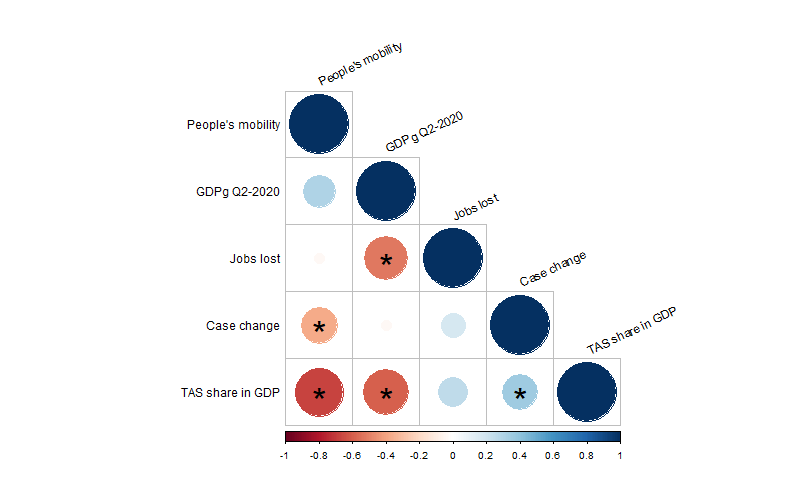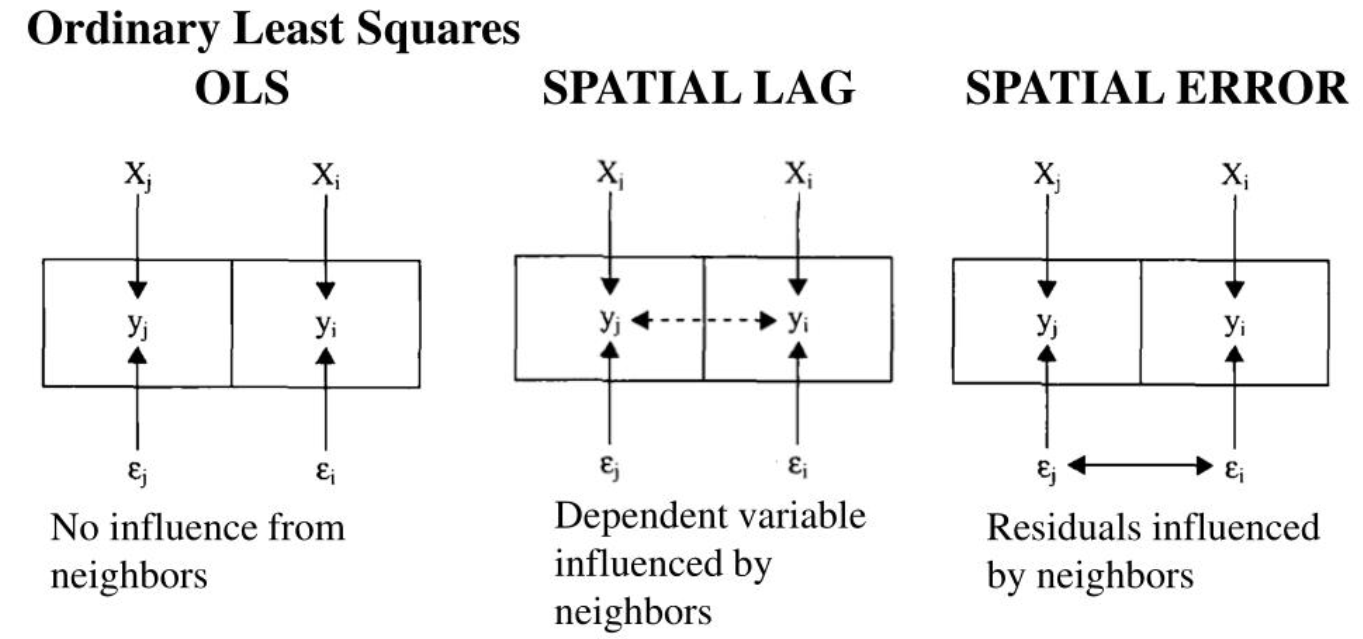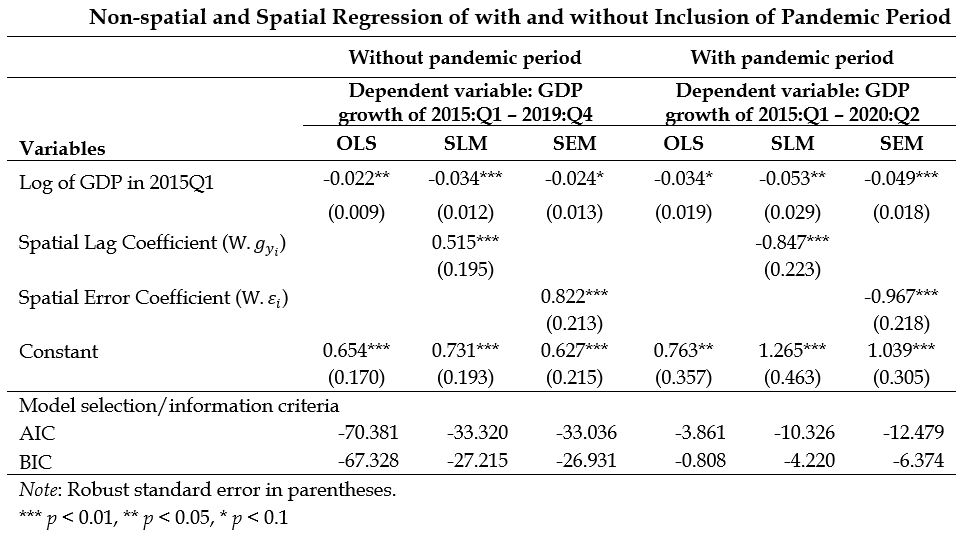class: center, middle, inverse, title-slide # Regional Economic Growth Convergence and Spatial Growth Spillovers at Times of <br/> COVID-19 Pandemic in Indonesia ### Harry Aginta, Ragdad C. Miranti, Carlos Mendez ### Nagoya University <br/><br/><br/><br/> Presented at the <span class="math inline">16<sup><em>t</em><em>h</em></sup></span> IRSA International Conference <br/><br/> 12 July 2021 --- ## Introduction: - COVID-19 leads to supply and demand shocks (Baldwin and Weder di Mauro 2020) - Negative supply shock stemming from reduction in production capacity (Hausmann, 2020; Inoue and Todo, 2020) - Declining workers' income leads to a shrinking in demand (Gourinchas, 2020) -- -- - Indonesia's economic growth in 2020 is projected to contract to –3.8% (OECD, 2020) -- -- - The negative impacts of COVID-19 on growth at province level have been observed in Q2-2020, albeit vary in magnitude. -- -- ## Objectives: - To provide initial exploration on the connection between COVID-19, the policy and regional economic growth -- -- - To study the difference of regional growth process and spatial growth dependence between two periods; before and after pandemic --- class: middle ## Methods: - Exploratory data analysis -- -- - Spatial econometrics -- -- ## Data: - Exploratory data analysis - GDP (BPS), output gap (own computation), number of COVID-19 cases **([https://kawalCOVID19.id](https://kawalCOVID19.id))**, people's mobility **([Google mobility](https://www.google.com/covid19/mobility/))**, number of lost jobs (Ministry of Manpower) - Period: Q2-2020 -- -- - Spatial econometrics - Quarterly provincial real GDP - GDP growth 2015:Q1-2019:Q4 (without pandemic period) - GDP growth 2015:Q1-2020:Q2 (with pandemic period) --- class: middle # Previous studies - McCulloch and Sjahrir (2008): spatial spillover matters in regional growth dynamics; districts surrounded by the fast-growing neighbors tend to grow faster -- -- - Suphannachart and Resosudarmo (2009): the poverty incidence in Sumatra is spatially dependent -- -- - Hill, Resosudarmo and Vidyattama (2008): there is (no) `\(\beta\)` convergence when mining sector is (not) included -- -- - Vidyattama (2013): the neighborhood effect does not affect the speed of convergence significantly --- class: middle # (1) Exploratory data analysis - Negative output gap (national and all provinces), economy below its potential level -- -- - Lowest economic growth in Q2-2020 mostly in Java-Bali region -- -- - GDP growth is negatively correlated with TAS (Transportation, Accommodation and Services) share in GDP and number of jobs loss -- -- - Positive correlation between the change in number of COVID-19 cases and the share of TAS in GDP -- -- - People's mobility is negatively correlated with the number of COVID-19 cases and share of TAS in GDP --- class: middle, center **COVID-19 cases in Indonesian provinces (daily cumulative, Apr-July 2020)** <br/> (per 100.000 population)  --- class: middle, center **Correlation between COVID-19 cases, economic growth, jobs lost, people's mobility and TAS share in GDP**  Further interactive exploration is available. <br/> **[https://haginta.shinyapps.io/covid19-econ-impacts-indonesia/](https://haginta.shinyapps.io/covid19-econ-impacts-indonesia/)** --- class: center, middle # (2) Convergence and spatial dependence Classical convergence (intuition) Spatial dependence (intuition) --- class: middle # Beta convergence framework (brief overview) `$$\begin{equation}\ln \left(\frac{y_{i, t+k}}{y_{i, t}}\right)=\alpha+\beta \ln \left(y_{i, t}\right)+\varepsilon_{i t}\end{equation}$$` The convergence hypothesis: `\(\beta\)` < 0 implies catching-up process or `\(\beta\)` convergence (Rey and Montouri, 1999) --- class: middle # Spatial dependence (brief overview) - Global spatial autocorrelation or Moran's I (Anselin, 2007) `$$I=\sum_{i} \sum_{j} w_{i j} \cdot\left(x_{i}-\mu\right) \cdot\left(x_{j}-\mu\right) / \sum_{i}\left(x_{i}-\mu\right)^{2}$$` where `\(w_{ij}\)` is spatial weight matrix (we use inverse distance), `\(x_{i}\)` is the score of the variable in location `\(i\)`, and `\(x_{j}\)` is the score of the variable in location `\(j\)`, and `\(\mu\)` is he cross-sectional mean of the variable. - Spatial econometric model Spatial lag model (SLM) `$$g_{y_{i}}=\alpha+\beta \log y_{i, 0}+\rho \mathbf{W} g_{y_{i}}+\varepsilon_{i}$$` Spatial error model (SEM) `$$g_{y_{i}}=\alpha+\beta \log y_{i, 0}+(\mathbf{I}-\lambda \mathbf{W})^{-1} \varepsilon_{i}$$` where `\(g_{y_{i}}\)` is the growth rate from initial to final period, `\(y_{i, 0}\)` is GDP at the initial period, and `\(\mathbf{W}\)` is spatial weight matrix. --- class: middle # Spatial lag model and spatial error model (conceptual comparison)  Source: Baller, R., L.Anselin, S.Messner, G.Deane and D.Hawkins (2001) --- class: middle, center # (3) Main results **Spatial dependence of provincial economic growth** Without vs with pandemic period: spatial cluster vs spatial heterogeneity  --- class: middle, center # (3) Main results (cont...) **Cpmparison between non-spatial and spatial models**  --- class: middle ## Discussion - In all models and all periods, there is `\(\beta\)` convergence -- -- - Both for SLM and SEM, the spatial coefficients `\(\rho\)` and `\(\lambda\)` are positive (significant) in without pandemic and negative (significant) in with pandemic period -- -- - `\(\rho\)` of SLM before the pandemic period implies positive spatial dependence in regional growth process (McCulloch and Sjahrir, 2008) but need to see direct and indirect effects (spatial spillovers) -- -- - Negative `\(\rho\)` of SLM indicates the absence of regional growth dependence when the pandemic period is included, resulting in an unsynchronized spatial growth. This may reflect the disconnection of economic interaction among people across provinces during ‘lock-down period’ due to pandemic --- class: middle # Conclusion and implications - The negative impact of COVID-19 pandemic on Indonesian economy is significant, massive decline of economic growth in Q2-2020 -- -- - In the regional growth process, there is positive (negative) spatial dependence before (after) the pandemic -- -- - The negative spatial dependence in the growth process during pandemic period may reflect the disconnection of economic interaction among provinces during ‘the lock-down period’ -- -- - Short-term: identify the resilient economic sectors in their respective province, stimulus to sustain local economy, cushion for the most vulnerable -- -- - Long-term: diversify the sources of economic growth across provinces, including by bringing the digital economy closer to the society -- -- ## Limitation - Need to consider other weight matrix - Data used in the models are very limited for the complex regional growth dynamics - Future studies: incorporate more variables, including the institutional factors --- class: center, middle # Thank you very much for your attention **https://haginta.github.io/Harry-Aginta/** Slides available at: <br/> **https://haginta.github.io/IRSA-slides/IRSA_slides.html#1** **Quantitative Regional and Computational Science lab** **https://quarcs-lab.org/** <br/> <img src="QuaRCS_logo.png" width="200"> ***